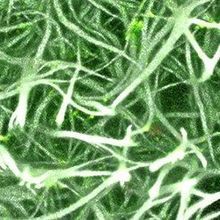actin cytoskeleton

Lighting Up the Neuronal Cytoskeleton
Mariella Bodemeier Loayza Careaga, PhD | Aug 1, 2024 | 2 min read
By combining microscopy techniques with genome engineering, scientists revealed the complexities of the presynaptic actin cytoskeleton.

How Intracellular Bacteria Hijack Your Cells
Catherine Offord | Dec 1, 2022 | 10+ min read
Scientists studying pathogens such as Chlamydia, Legionella, and Listeria get a master class in how to control the internal workings of mammalian cells.

Infographic: Intracellular Bacteria’s Tricks for Host Manipulation
Catherine Offord | Dec 1, 2022 | 2 min read
Various microbes, including several human pathogens, hijack the cell’s skeleton, membranes, and protein-making machinery to make themselves at home.

Cancer Cells Gather Speed in Thicker Fluids
Holly Barker, PhD | Nov 22, 2022 | 4 min read
Viscous solutions accelerate the migration of tumor cells and may enable metastasis, according to a new study.

Cell Chirality Offers Clues to the Mystery of Body Asymmetry
Catherine Offord | Feb 1, 2022 | 10+ min read
Researchers explore the idea that molecular patterns in individual cells could underlie the development of a left and a right in animals.

Infographic: The Emergence of Chirality in the Cell Cytoskeleton
Catherine Offord | Feb 1, 2022 | 1 min read
Researchers use imaging to show how actin fibers tilt and then swirl to create left-right asymmetry in the cell.

Derek Applewhite’s Actin Research Inspires the Next Generation
Lisa Winter | Mar 1, 2021 | 4 min read
The biologist’s undergraduate-centered lab allows students to play a meaningful role in research.

Image of the Day: Artificial Cell
Sukanya Charuchandra | May 31, 2018 | 1 min read
Researchers made a synthetic cell that can photosynthesize and make proteins crucial for cellular structure.

Image of the Day: Lysosomes Go Traveling
The Scientist | Aug 8, 2017 | 1 min read
To chew up waste in far-reaching dendritic spines, lysosomes are trafficked sometimes hundreds of microns away from the cell bodies of neurons in rats.
